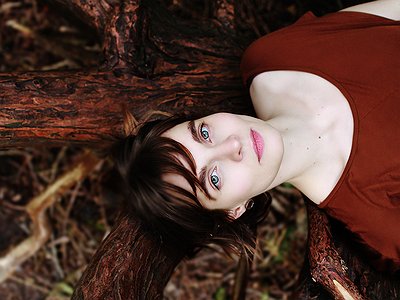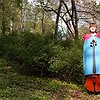Part 1
Name: Hildur Guðnadóttir
Nationality: Icelandic
Occupation: Composer, cello player, vocalist
Selected Projects: Trapped (TV Series), Jóhann Jóhannsson, Throbbing Gristle
Label: Touch
Musical Recommendations: Eyvind Kang, Jessika Kenney
If you enjoyed this Hildur Guðnadóttir interview and would like to find out more about her work and music, visit her official homepage. She is also on Instagram, and Facebook.
When did you start composing - and what or who were your early passions and influences?
For example, the oboe not only has it’s sound, but it also has the personality of my aunt Eydís. Most instruments have a personality attached to them in my mind. So music is also about communicating on a personal level for me. Playing music with people is always equally as much about friendship as it is about music.
This comes through in other ways as well. As a composer, when you write a score you are communicating through writing and visual imagery. Your personality comes out in the score. I find it such an interesting form of communication.
For most artists, originality is first preceded by a phase of learning and, often, emulating others. What was this like for you? How would you describe your own development as an artist and the transition towards your own voice?
I started learning the cello when I was 5 years old. When you learn to play a classical instrument, you spend most of your time trying to sound like what you are told to sound like. I had a really hard time with this.
The fact that there was a “right way” to play never made any sense to me, so as a result I had a really hard time connecting to the cello for most of my childhood. However I still think it was really important for me to have spent all that time learning about techniques and the classical way of playing because that allowed me to find my own voice later on when I was ready.
I started out playing with bands when was a teenager, and it was there that I got the space I needed for the playful and experimental approach to music that has always been very important to me. I started to mix all those elements in my late teens and that is when my music started to make sense to me.
What were some of the most important creative challenges when starting out as a composer and how have they changed over time?
When you are starting out it’s probably most difficult to find your voice; to work out how you want to communicate and what you have to say. I can imagine this has always been the case. We have so many ways of communicating these days; technology is making it both easier and harder for us.
One of the biggest challenges I find as a composer (or just a person really) is keeping focus and a steady pace in all the noise and fast pace of today’s way of living.
Tell us about your studio/work space, please. What were criteria when setting it up and how does this environment influence the creative process? How important, relatively speaking, are factors like mood, ergonomics, haptics and technology for you?
I have a studio in Berlin. I share it with a group of guys. It’s a whole floor in an old factory building that is divided into a number of small private studio rooms. Some of my dearest friends and closest collaborators share the studio with me, which is really wonderful and makes our working process quite fun and dynamic.
Jóhann Jóhannsson is the person I have probably worked with the most over the last decade. He used to live in Copenhagen, and we used to always have to send music back and forth. Now he’s on the other side of my wall every day, and it makes our working process a lot more organic.
The mood of my room is also very important to me. I have a huge window and lots of natural light. I am surrounded by all my instruments. I am working on a lot of experimental instruments and that takes up quite a bit of space. So my studio often turns into a sea of cables, soldering irons and tiny bits and pieces.
In general I try to keep my studio a warm place where my mind can breathe.
Could you take me through the process of composing on the basis of one of your pieces that's particularly dear to you, please? What do you start with when working on a new piece, for example, how do you form your creative decisions and how do you refine them?
I try not to get stuck in one method of composing. I also perform a lot of my own music myself, so writing for myself is very different to when you are composing for other people.
I try to tap into my curiosity when I am composing, because that turns on my enthusiasm and turns my ego down. When I write a solo piece for myself, I often start out playing a certain timbre for a really long time until I get lost in it and spin out a world from there.
I find it very helpful to draw when I am starting on a new score for others to play. That connects my sense of sculpting form to paper. My drawings are like inner dialogues that prepare my dialogue with the musicians. Some pieces of mine – for example my orchestra piece ‘Under Takes Over’ - are based on those drawings.
What, if anything, do you personally draw from the cosmos of electronic music and digital production tools that is inspiring for your daily practise? In how far do you see the potential for a mutual creative pollination between the two?
Technology shapes what I do a lot. I record, play and mix most of my music myself, and that is only possible because of technology advancing so much in recent years. I also work quite a bit with electronics.
The instrument I have been playing and helping to develop in the last years is also extremely technologically advanced. I call him Ómar. He was built by my good friend and genius Hans Johannsson. Ómar’s brain, as I call it, was built and designed by Patrick Gaydecki, professor of digital signal processing. It aims to digitally manipulate the raw waveform of the bowed string instruments using sophisticated signal processing hardware and codecs developed by Gaydecki. The hardware is embedded in the instrument.
To put it as simply as I can, Ómar’s brain simulates another instrument, so even though Ómar is an electric cello he sounds exactly like an acoustic cello. Having worked with amplified string instruments for over half my life, I can safely say that this is a complete game changer. There’s zero feedback, zero sound leakage and it sounds amazing!
Ómar is also an electro-acoustic surround instrument and has many different bodies, which are physical resonating sound chambers that I can spread around a space. So in short he is an embodiment of all my obsessions.






